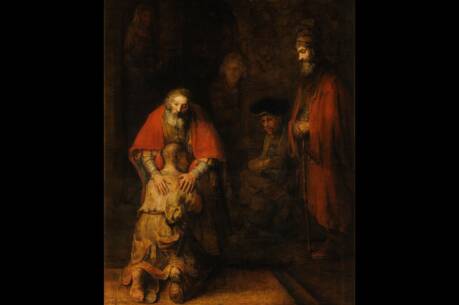A No-Nonsense Message!
The annual Easter proclamation reminds us of St. Augustine’s hymn to beauty (God): ever ancient, ever new. At the door of the tomb, the realm of death, the women hear an affirmation of life: He is not here, but he has been raised. Echoing through the centuries, this is the foundation of Christian belief, yet each Evangelist scores it with different notes. The women who had followed Jesus from Galilee to the cross (8:1-3; 23:55) come to perform burial rites in love and devotion. They are greeted by two figures in white (the number of required legal witnesses), who announce the astounding news of the resurrection; then only Luke adds, Why do you seek the living among the dead? The messengers then summon the women to an act of remembrance of Jesus’ words, that as suffering Son of Man he would be handed over to crucifixion. Joyously remembering these words, the women announce all these things to the Eleven and to the Apostles, who were last mentioned at the Last Supper and who did not follow Jesus to the cross. They dismiss the women’s announcement as nonsense, and Peter, as in John 21:1-13, runs to the tomb, sees the burial clothes and is amazed.
Distinct and powerful Lukan themes emerge. From his initial proclamation at Nazareth until his death, the Lukan Jesus is a prophet who brings God’s word but who will be rejected, as were John and the prophets of old. His prophetic words are now fulfilled. Only after remembering these do the women become heralds of the resurrection. The enduring power of the words of Jesus reverberates through the Lukan resurrection appearances, as the risen Jesus himself will break open the Scriptures for his followers.
Resurrection faith today is not simply an affirmation of Jesus’ victory over death and of his exaltation and enduring presence. It is a summons to return to the words and deeds of Jesus in the Gospel.
Especially challenging is the Apostles’ disbelief and dismissal of the women’s message. Some see it as first-century cultural bias against women’s testimony and proclamation, a bias that remains alive in the 21st century. Though Peter acts on the women’s message, he is simply amazed at the empty tomb and not yet a believer. In Luke’s theology not even the word of Jesus is enough to bring people to faith; they must have an experience of Christ’s presencewhich occurs in the following appearances to the disappointed Emmaus walkers and the puzzled disciples. Christian faith does not rest on an empty tomb, but on the continuing experience of the risen one.
The resurrection proclamation to the women summons the disciples to remember not only the powerful words and deeds of Jesus, but his suffering and death. Resurrection faith shares space with the horror of memory of a century when death seemed more regnant than life. The Vatican document on the Holocaust (Shoah), We Remember (3/16/98), calls on Christians to keep alive the scandal of its memory and to admit that in the past they departed from the spirit of Christ and his Gospel. It concludes that the victims from their graves, and the survivors through the vivid testimony of what they have suffered, have become a loud voice calling the attention of all humanity. Voices continue to be raised from the graves of victims of worldwide acts of genocide and other forms of lethal violence.
The message of resurrection, ever ancient, ever new, is that Christ is not here inhabiting the realm of the dead, but has emptied death of its power. Christians today are summoned to live, proclaim and celebrate this victory by resisting all those forms of death and violence that saturate our culture. The women at the tomb remember the words of Jesus about suffering; their story, dismissed as nonsense, was that Jesus was raised up from the tomb, but only after descending into death’s chamber.
The flowers that adorn our homes and churches this Easter came from seeds that died and were transformed, just as Christian life can flower through the mystery of the cross. The words from the Easter sequence capture this beautifully: mors et vita duello conflixere mirando, life and death are locked in wondrous struggle. The struggle endures, though ultimate victory is assured: dux vitae mortuus regnat vivus, life’s leader, once dead, reigns as the living one.
This article also appeared in print, under the headline “A No-Nonsense Message!,” in the April 9, 2001, issue.







